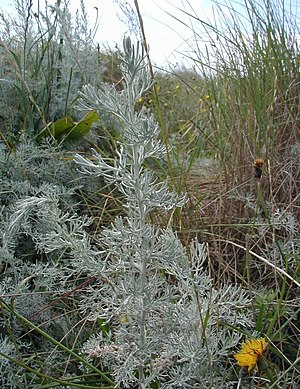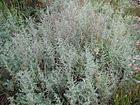Note: This is a project under development. The articles on this wiki are just being initiated and broadly incomplete. You can Help creating new pages.
Difference between revisions of "Artemisia maritima"
| Line 2: | Line 2: | ||
'''Artemisia maritima''' is a strongly aromatic, herbaceous perennial plant growing from a short, usually branching, woody rootstock. The plant produces a mat of non-flowering rossettes. The plant is harvested from the wild for local use as a medicine. | '''Artemisia maritima''' is a strongly aromatic, herbaceous perennial plant growing from a short, usually branching, woody rootstock. The plant produces a mat of non-flowering rossettes. The plant is harvested from the wild for local use as a medicine. | ||
==Uses== | ==Uses== | ||
| − | {{Uses| | + | {{Uses|Skin eruptions}}. |
==Parts Used== | ==Parts Used== | ||
| − | {{Parts Used| | + | {{Parts Used|Leaves}}. |
==Chemical Composition== | ==Chemical Composition== | ||
| Line 17: | Line 17: | ||
===Dravya=== | ===Dravya=== | ||
===Rasa=== | ===Rasa=== | ||
| − | |||
===Guna=== | ===Guna=== | ||
| Line 30: | Line 29: | ||
==Habit== | ==Habit== | ||
| − | {{Habit|}} | + | {{Habit|Deciduous Perennial}} |
==Identification== | ==Identification== | ||
| Line 49: | Line 48: | ||
==Mode of Propagation== | ==Mode of Propagation== | ||
| − | {{Propagation|}} | + | {{Propagation|Seeds}} |
==How to plant/cultivate== | ==How to plant/cultivate== | ||
| − | <ref name="How to plant/cultivate"/> | + | Succeeds in any soil but prefers a poor dry soil with a warm aspect.<ref name="How to plant/cultivate"/> |
==Commonly seen growing in areas== | ==Commonly seen growing in areas== | ||
Revision as of 18:41, 27 March 2020
Artemisia maritima is a strongly aromatic, herbaceous perennial plant growing from a short, usually branching, woody rootstock. The plant produces a mat of non-flowering rossettes. The plant is harvested from the wild for local use as a medicine.
Contents
- 1 Uses
- 2 Parts Used
- 3 Chemical Composition
- 4 Common names
- 5 Properties
- 6 Habit
- 7 Identification
- 8 List of Ayurvedic medicine in which the herb is used
- 9 Where to get the saplings
- 10 Mode of Propagation
- 11 How to plant/cultivate
- 12 Commonly seen growing in areas
- 13 Photo Gallery
- 14 References
- 15 External Links
Uses
Parts Used
Chemical Composition
Common names
| Language | Common name |
|---|---|
| Kannada | |
| Hindi | |
| Malayalam | |
| Tamil | |
| Telugu | |
| Marathi | |
| Gujarathi | |
| Punjabi | |
| Kashmiri | |
| Sanskrit | |
| English |
Properties
Reference: Dravya - Substance, Rasa - Taste, Guna - Qualities, Veerya - Potency, Vipaka - Post-digesion effect, Karma - Pharmacological activity, Prabhava - Therepeutics.
Dravya
Rasa
Guna
Veerya
Vipaka
Karma
Prabhava
Habit
Identification
Leaf
| Kind | Shape | Feature |
|---|---|---|
Flower
| Type | Size | Color and composition | Stamen | More information |
|---|---|---|---|---|
| {{{5}}} |
Fruit
| Type | Size | Mass | Appearance | Seeds | More information |
|---|---|---|---|---|---|
Other features
List of Ayurvedic medicine in which the herb is used
Where to get the saplings
Mode of Propagation
How to plant/cultivate
Succeeds in any soil but prefers a poor dry soil with a warm aspect.[3]
Commonly seen growing in areas
Drier parts of salt marshes, Sea walls.
Photo Gallery
References
External Links
- [ ]
- [ ]
- [ ]
Categories:
- Ayurvedic Herbs known to be helpful to treat Skin eruptions
- Herbs with Leaves used in medicine
- Habit - Deciduous Perennial
- Index of Plants which can be propagated by Seeds
- Herbs that are commonly seen in the region of Drier parts of salt marshes
- Herbs that are commonly seen in the region of Sea walls
- Herbs
- Pages without herbs images





